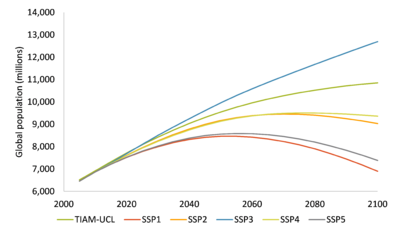Economic activity - TIAM-UCL
| Corresponding documentation | |
|---|---|
| Previous versions | |
| Model information | |
| Model link | |
| Institution | University College London (UCL), UK, https://www.ucl.ac.uk. |
| Solution concept | Partial equilibrium (price elastic demand) |
| Solution method | Linear optimisation |
| Anticipation | Perfect Foresight
(Stochastic and myopic runs are also possible) |
GDP
Estimations of future economic growth are much more uncertain than future population growth. Few studies exist that forecast GDP up to 2100 and so unlike population assumptions, GDP figures in TIAM-UCL are not based on a single source. Economic growth rates have been compared to assumptions made for scenarios in the 4th assessment report of the IPCC (Tsuneyuki 1999) and Clarke et al. (2007). Global GDP is assumed to grow from $50 trillion in 2010 to $155 trillion in 2050 and $350 trillion in 2100 (all GDP are in 2005 US$). Current figures for 2010 have been taken from the IMF (2009).
Figures for future economic growth are based on an approximate assumption of economic convergence between regions (see Figure 3 5), i.e. that low income regions grow faster compared to high income regions. The figure shows this convergence of per capita income among world regions. The GDP per person is calculated as the ratio of GDP and population. The economic convergence is a central point in the assumptions on socio-economic drivers. The effect becomes clear when one compares the GDP per head in different regions. In 2005 India is the poorest region with a GDP per head of 10% of the world average and the USA is the richest region with 600% of the world average. In 2100 this picture changes with India having a GDP per head that has now grown to 55% of the world average and the USA being the richest country with 350% of the world average.
GDP growth rates are expected to decline over the course of the 21st century, while they remain higher for developing countries than for developed countries. Owing to the shrinking population, the growth rates for South Korea and Japan are very low and turn negative at the end of the 21st century. Growth rates for Western Europe, the UK and the United States are assumed to drop from an average of 2.2% to 1.3% p.a. in 2050. The only region that is expected to increase GDP growth rates over the first decades is Africa based on a growing population and its current low income levels. Global economic growth is approximately in the mid-range of the growth in the SSP scenarios
<figure id="fig:GDP per capita">
 </figure>
</figure>
Sectoral drivers
Industrial production is subdivided into chemical industry, iron & steel and non-ferrous metals, pulp & paper and non-metallic minerals, and other industries. Initial numbers are based on number from ETSAP-TIAM published by KANORS (2010).
The development of sectoral growth rates are geared to the GDP numbers and imply a shift in GDP composition towards the service sector, so that agriculture and industry will become less important for the whole economy over the 21st century. To this end, the GDP composition of the most important regions has been extracted from national statistics according to the sectoral aggregation in TIAM.
Sectoral drivers have been calibrated in such a way that they yield a more service-orientated economy.
In addition, the driver for the iron & steel industry is geared to historical data on steel production obtained from statistics of the World Steel Association.